In one of this game week’s biggest clashes in the UEFA Champions League, Juventus welcomed Atletico Madrid in what was beforehand seen as a battle for the first place in group D. Anyhow, the home team sat in the highest spot before this duel and wanted to maintain it so they could officially wait for the knockout phase draw from the privileged position.
Maurizio Sarri’s men managed to save all three points in a highly physical duel and to fulfil their plans with a 1:0 win in this fixture. This tactical analysis will show you how the hosts overpowered the Spaniards using their tactics and being well-organised throughout the 90 minutes.
Lineups
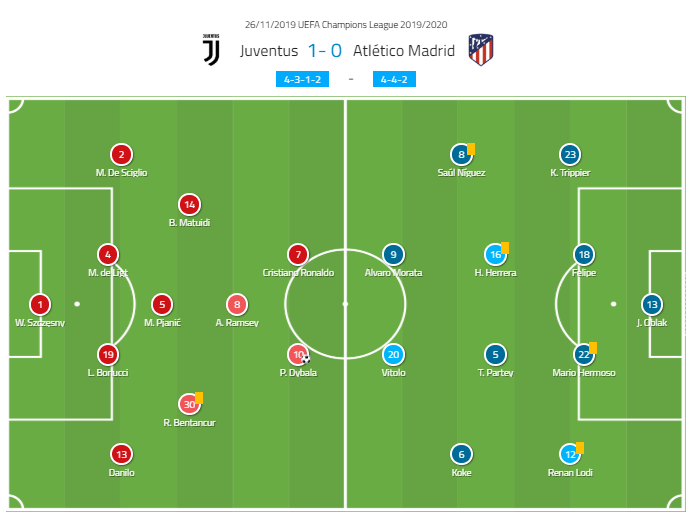
The home team’s coach went into the game in their most common 4-3-1-2 formation that went through a lot of modifications in different phases of play. Their discipline came from the tight organisation in the midfield which was held by Miralem Pjanić, Rodrigo Bentancur, and Blaise Matuidi, with Aaron Ramsey on top of the midfield irregular diamond. The main attacking forces were Cristiano Ronaldo and Paulo Dybala, as it was expected, and they roamed and rotated with their lower teammates.
Diego Simeone set his side in his prefered 4-4-2 formation trying to play their game in a direct tough athletic manner. Koke and Saúl Ñíguez once again played as the “first violins” of their team from the flanks in both offensive and defensive actions as they were in charge of creation and pressing organisation, where they had help from Thomas Partey and Héctor Herrera who coordinated in the central zones of the field. In absence of João Félix, who still wasn’t fit to play for the entire 90 minutes, the attacking duo was made up of Vitolo and Álvaro Morata.
Play organisation and midfielder roles
Right from the first minute, both teams entered the match with clear intention to play in a physical manner with a lot of running and duels. Atlético Madrid tended to narrow the field of operation for their rivals who set themselves as the ones trying to get to the goal through possession.
The visitors were very close to their opponents, sitting tight in the defensive block who went from the central one into the lower type of it depending on the phase of the attack Juve were in. Even though the away team wanted to catalyse the opposition play in the restricted corridors, Sarri’s full-backs provided the width and enabled their team to switch the action to the further flank.
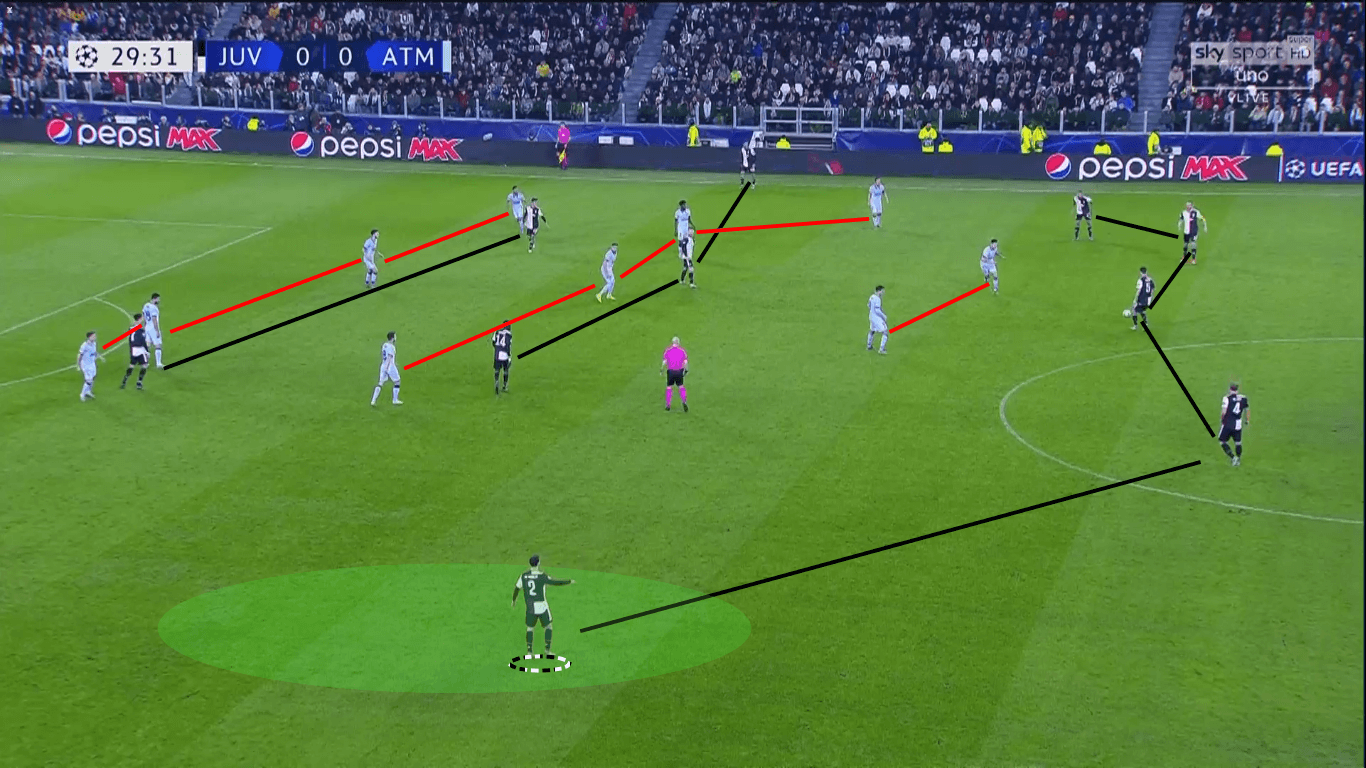
Matia de Sciglio on one side, and Danilo on the opposite repeated positioning in the shown way and made it possible for their side to get out of the crowded room Simeone wanted to bring them in. Atleti’s players were strict in guarding the direct rivals and managed to close down the progressive lanes to the attackers but the Bianconerri coped with their structure very well and had found the flaws in their setup.
The attacking part of Juventus constantly repeated similar motions in which one of the midfielders and one of the strikers went to the flanks while the second striker and Ramsey asked for the ball in the gaps between the lines.
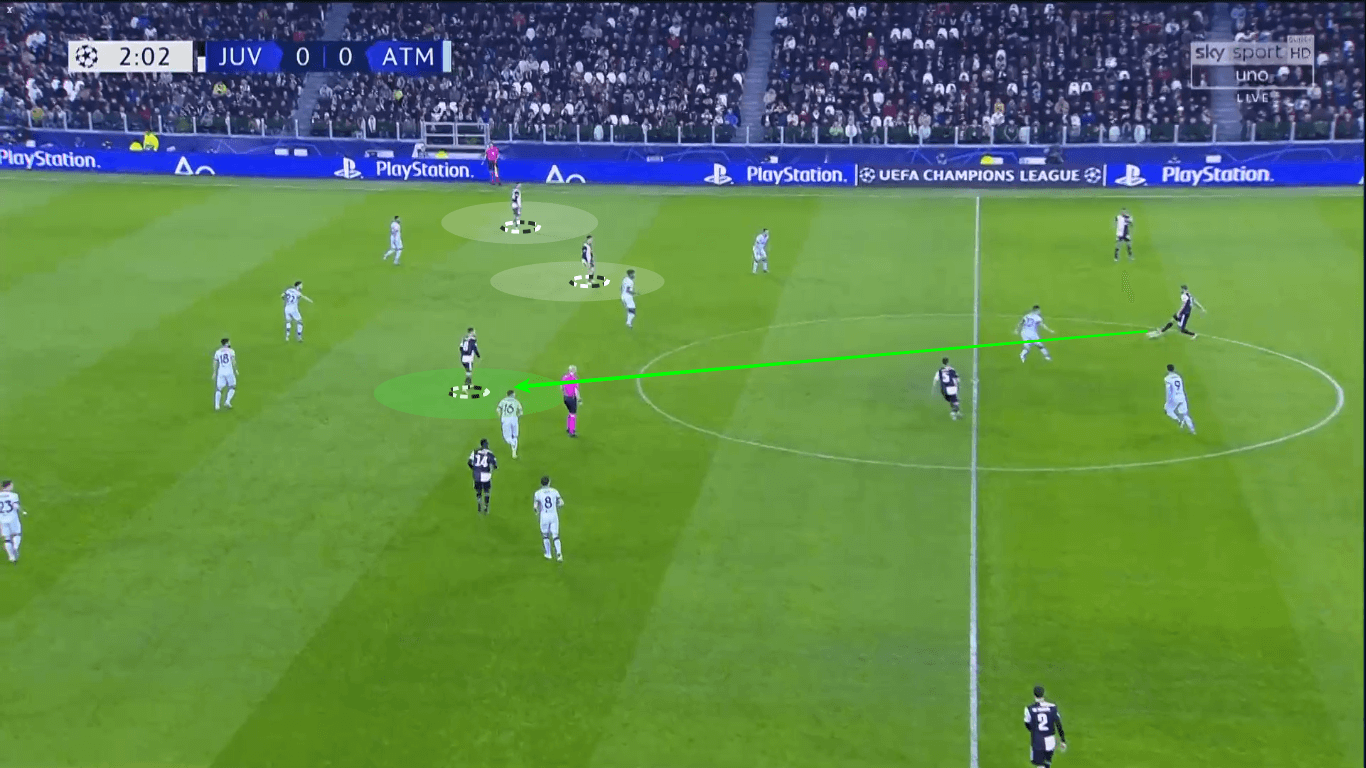
Dybala was most often the second guy playing in those zones alongside the Welshman and they did a great job finding an empty room in those areas. That enabled their team to move through lines as they wanted, while the “plan B” for them was to play it out wide where Ronaldo and either Bentancur or Matuidi were waiting for the ball.
The inside-positioning of Ramsey and the support he got from lower midfielders made it possible for Juve to break the away team’s block and to get in the surplus situations in the “touchy” zones. He frequently had a tendency of creating triangles with the striker and one midfielder which led them to prosper and to move the place of the action to the opponent’s half.
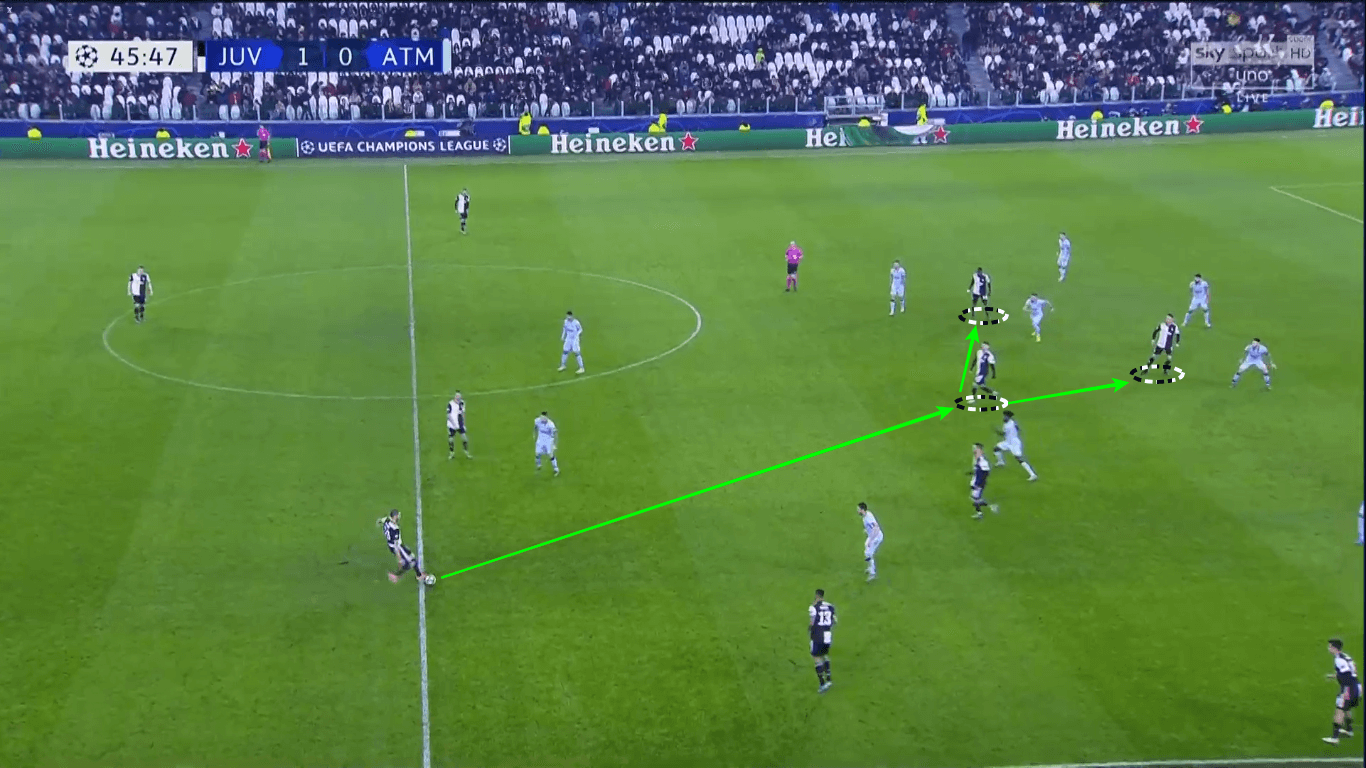
As we can see, the Bianconerri’s trio has created a triangle in the central-corridor allowing their side to move forward and to beat opposition’s first defensive line. The player to whom the first ball was addressed always had two options for his next pass and that was of huge importance since both teams let their rivals have very little space to manoeuvre all around the pitch.
Midfielders also had a huge impact on Juventus’ direct play that was easily seen in their run-in game.
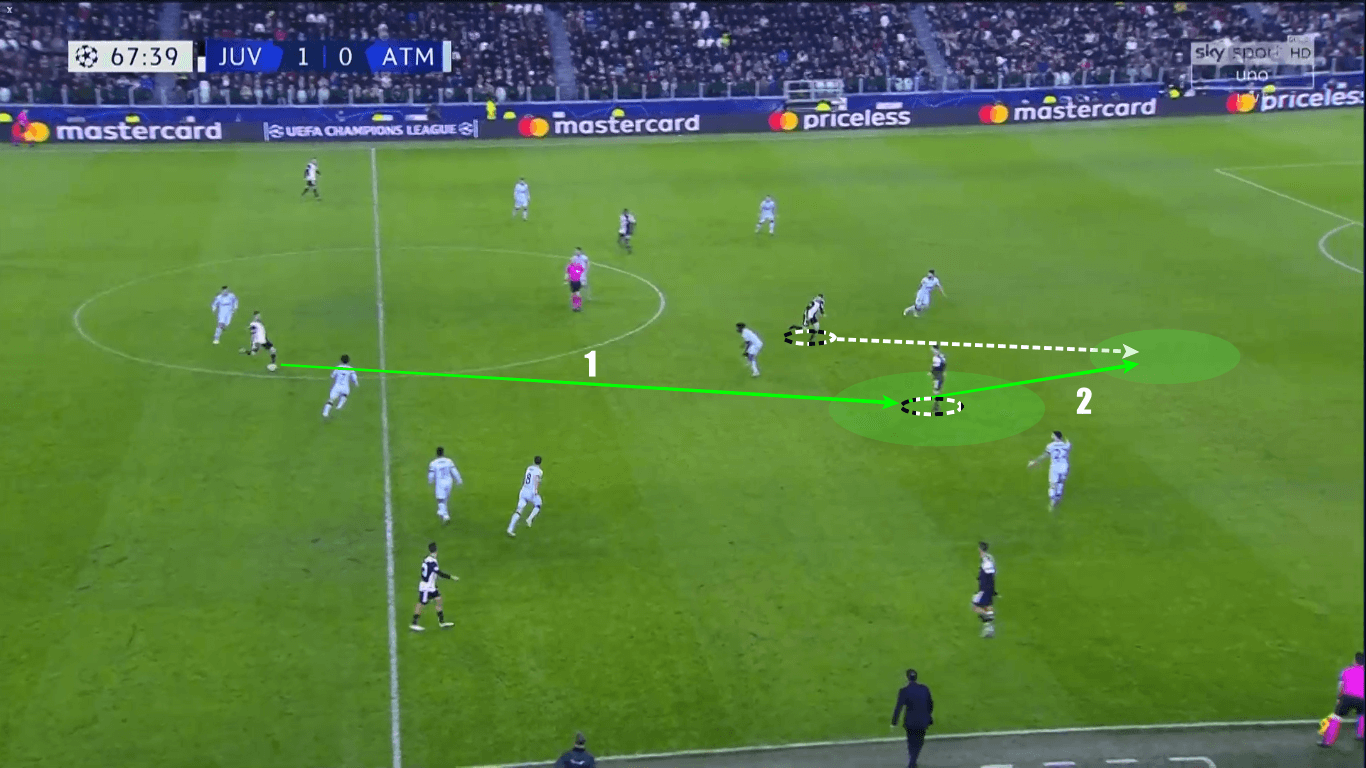
The home side’s strikers often rotated with midfielders and lowered themselves to become included in the play organisation and, as it is shown above, asked for the ball in the deeper parts of half-spaces. Players in the attacking midfielder position used those scenarios to repeat their high runs into the free space and from time to time managed to come into good goal-scoring positions.
Breaking Atlético Madrid’s pressing
Simeone’s men went into the game with a clear high-pressure approach and tried to push the force the opposition into errors in their opening third of the pitch. They played with man-marking all over the opponent’s half and tried to close down the pass-forward lanes, staying near their rivals.
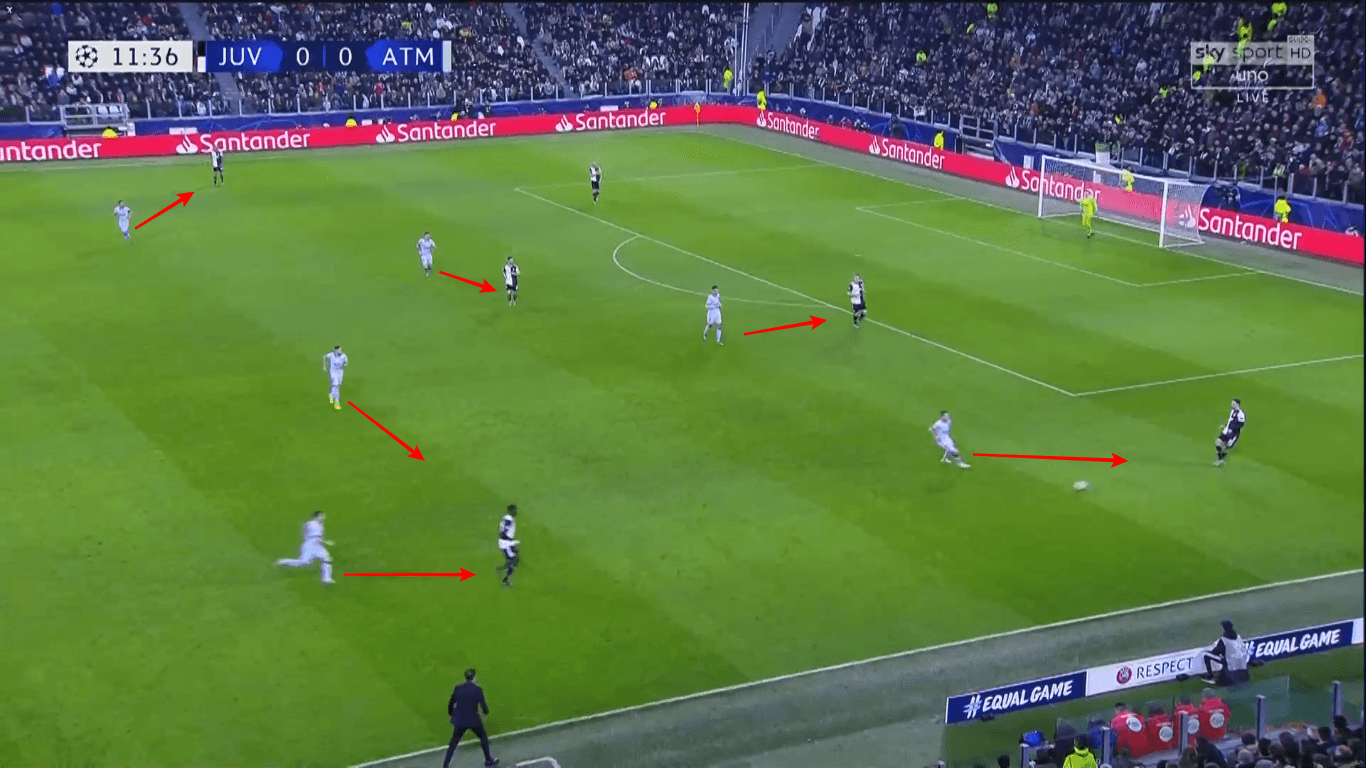
The visitors repeated those runs throughout the whole match but Juventus found the way to break their pressing by staying cold-blooded in tough positions and being secure on the ball in the build-up phase of their attack. Their midfielders did a great job motioning and opening up for breakthrough passes which enabled Leonardo Bonucci and Matthijs de Ligt to supply them with balls in the opening stage of the play.
Bentancur and Pjanić were mostly the ones asking for the first progressive passes as they time and again set themselves in unguarded rooms behind the first line of Atleti’s pressing which made them open to get the ball.
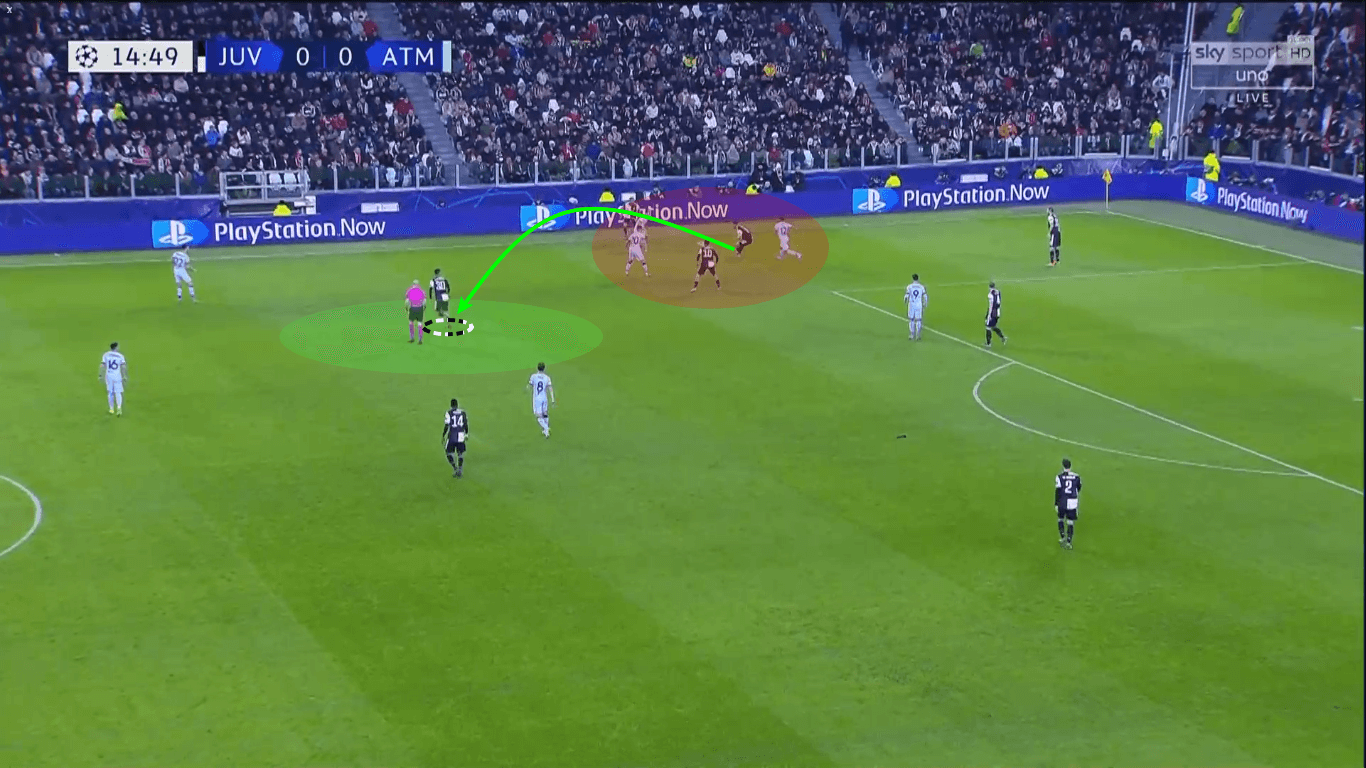
In the picture, we can see how Juve’s midfielder came close to the action to provide his pressured teammates with a forward-option. The hosts didn’t panic in those situations and kept their cool so they managed to break the initial pressure with ease very habitually.
The rotations of the higher players with the lower ones also enabled Sarri’s team to overpower the opposition in those scenarios and to get out of the uncomfortable setups. Dybala was often the one coming down to help in the play-organisation which made him the player through which they could initiate forward play so he got a lot of under-pressure passes addressed to him. The midfielders then exploited the free room that was left open after the Argentine’s direct guard continued following him as the part of team pressing, so he left his position and enabled Juve progress.
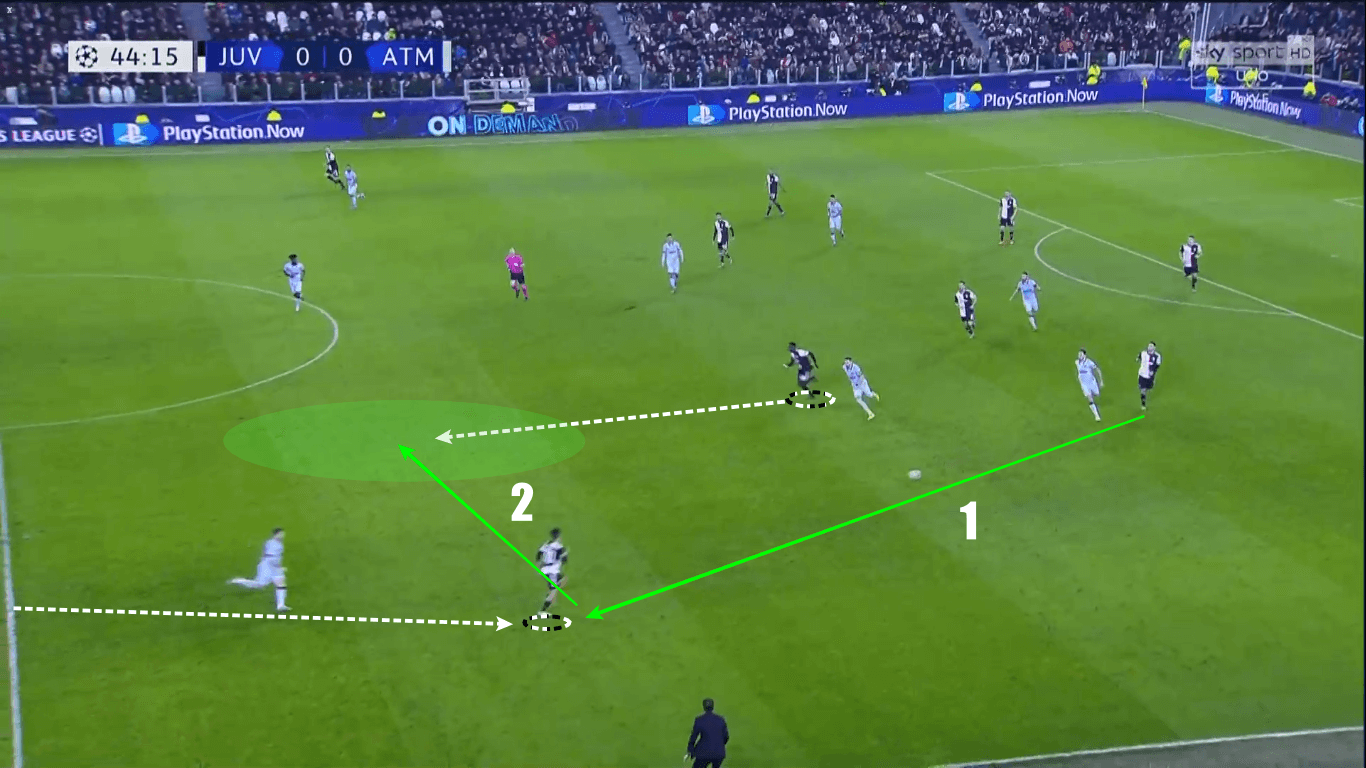
Matuidi overlapped down the inner-corridors providing his team with a breakthrough option and always being the man who will win the space for his side both with his runs without the ball or with the ball in his feet. Those motions disrupted Atlético Madrid’s pressing game and brought Juve in better positions from where they could play it more transitively, or could wait and play it in a possessional manner.
Juve’s defensive organisation and countering
Even though the host were the ones in control of the ball in the majority of the match, they played a disciplined defence when they weren’t in possession. They transformed themselves in those phases of play and often switched approaches so they went from the high-pressure shapes to central or even low blocks from time to time.
Their main idea was to play it strictly man-oriented in defence while also protecting the space at the same time. Juve were very organised and moved through the pitch simultaneously and it was clear that they are well-drilled, which was seen in their manner of “caging” opponent’s creative players and stopping their progress.
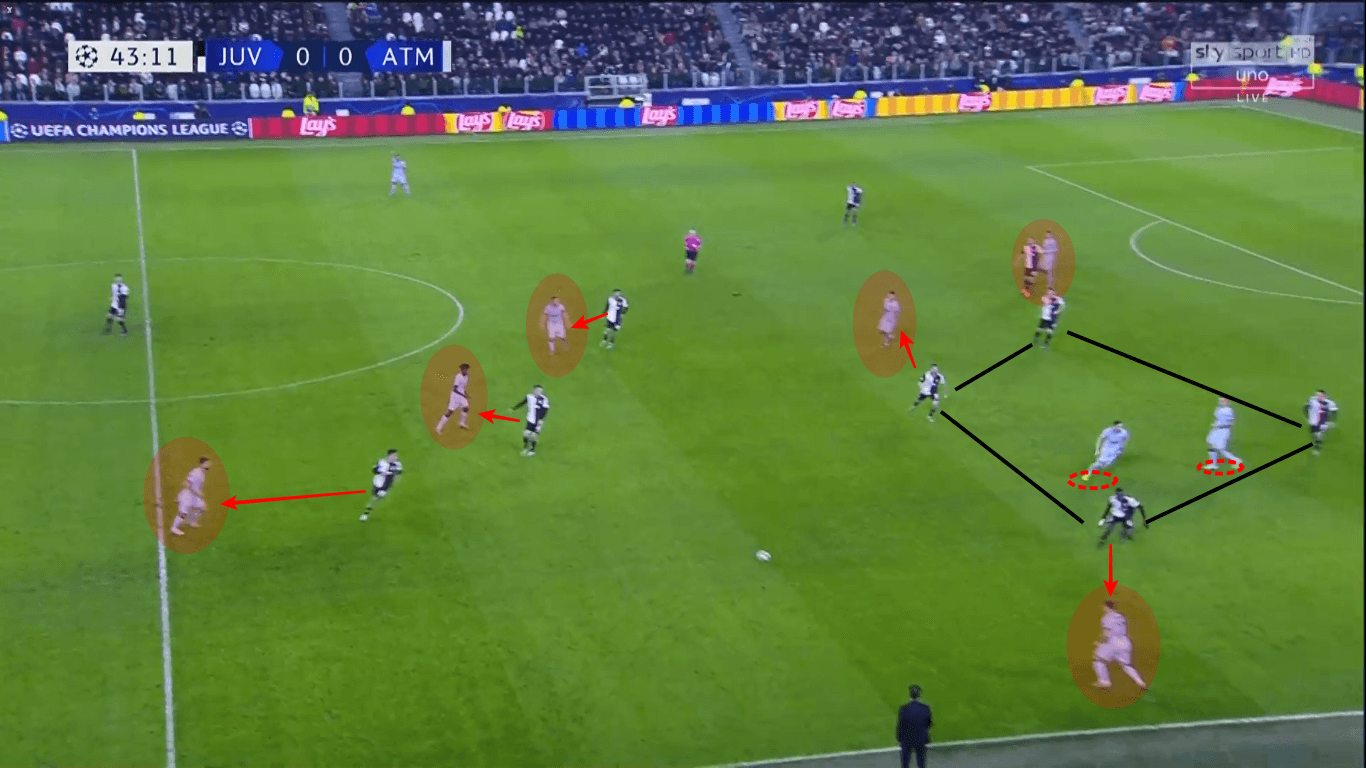
As we can see above, Sarri’s men moved systematically and disabled Atlético’s forward-play by sitting very close to each one’s direct rival. They managed to perform great negative transition out of the high pressing structure and maintained the same-distanced shape in all of the zones of the pitch.
When the visitors tried to attack possessionally, Juventus sat narrow in their block orienting their defensive structure to central and inner corridors, focusing themselves on protecting the deep passing lanes to the inwards positioned attackers of Simeone’s side. They intentionally left the players on the flanks open as they counted that they have an air-advantage over the Madrid’s forwards so they asked the opposition to try with crosses rather than to play it centrally with short passing.
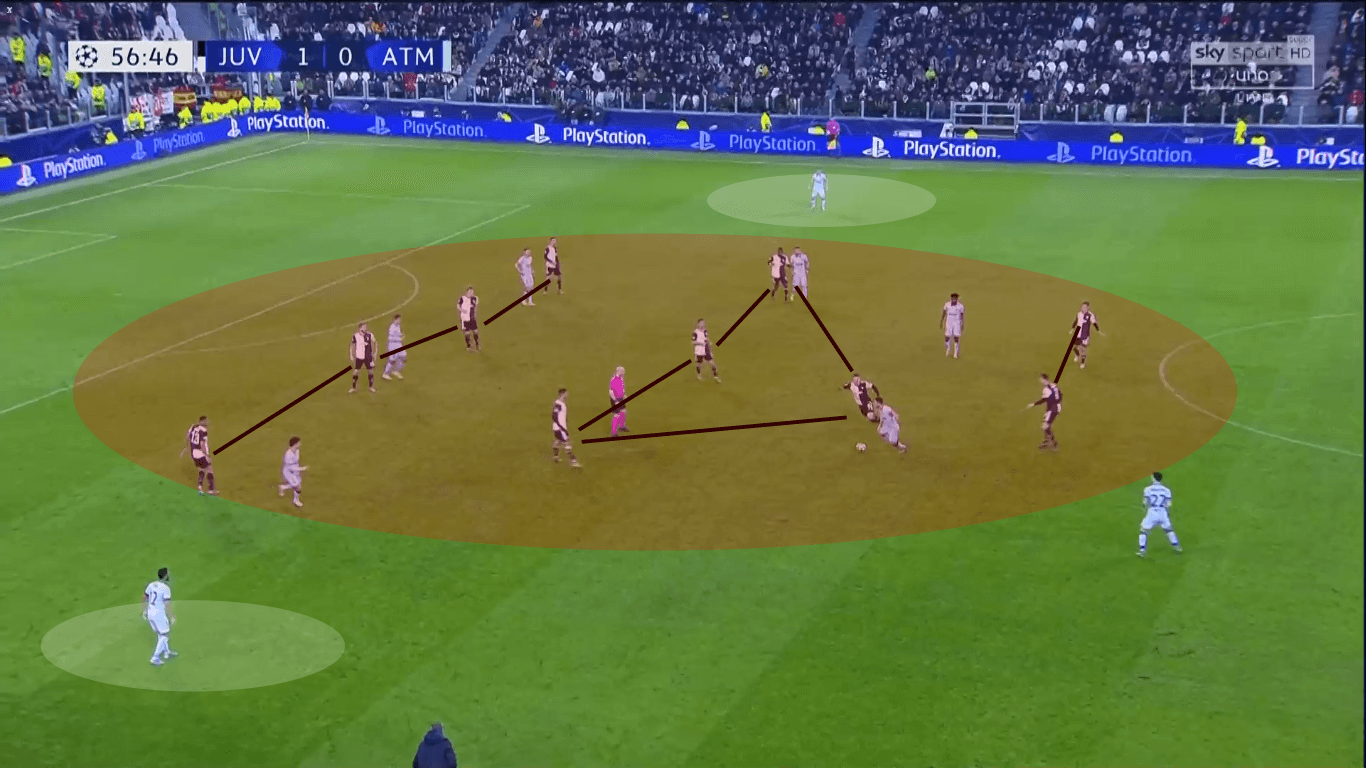
All of the Juve players moved perfectly when out of possession which made their block look very neat and magnificently organised. The midfielders who were playing in a diamond shape communicated pretty well and were the ones pressing the players next to the sidelines if the opportunity was shown.
From these tight setups, the Bianconerri tended to endanger the opposition through the counter-attacks which were mostly based on a long-ball game to the strikers. Two of them provided huge support to each other, while the midfielders also came closer to them to help if it was needed.
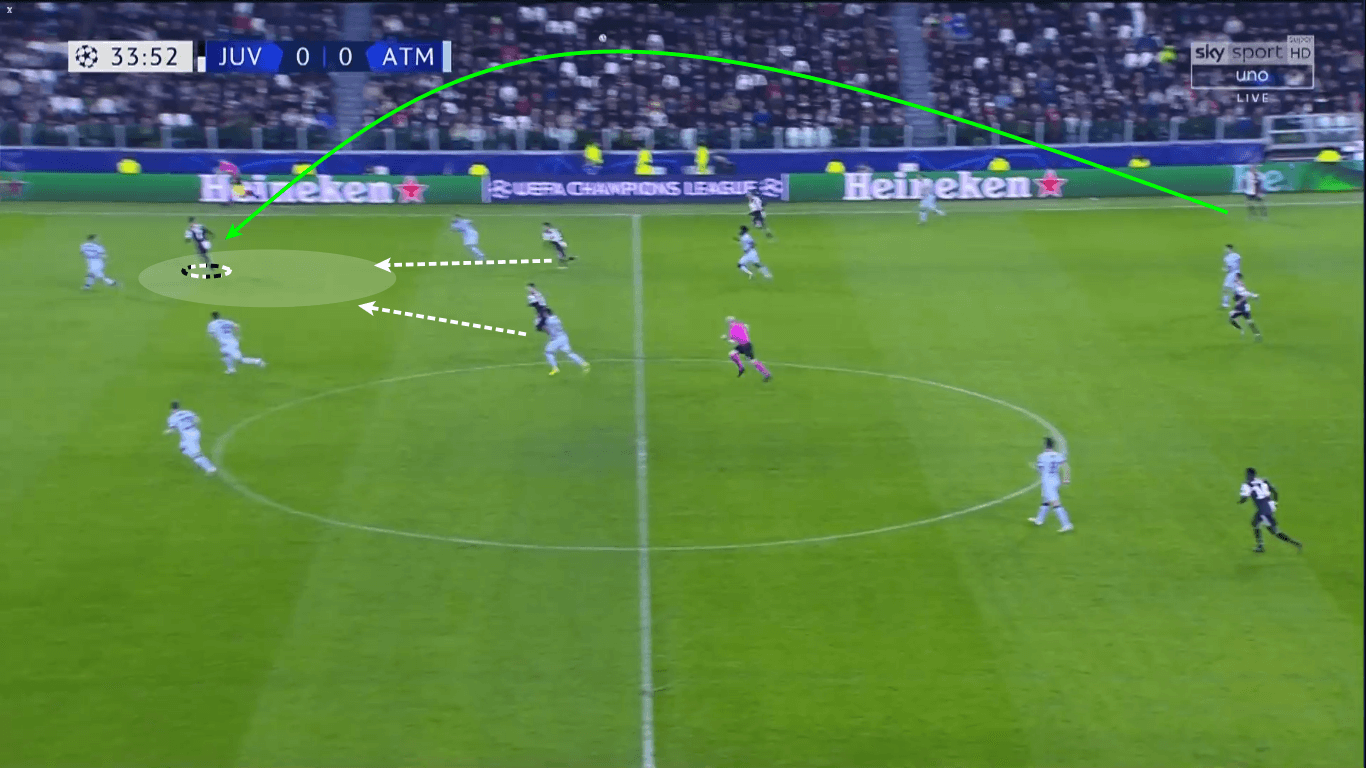
Juventus used balls like the one shown above periodically and tried to skip the play by repeating them. That enabled them to break their opponent’s pressure and moved the action to the attacking part of the pitch. The key for their success in those scenarios was the second-ball game in which the hosts were brilliant as they’ve won most of them in tough duels due to good timing and the great movement of their players.
Conclusion
The home team deserved the win, as it is shown in this analysis‘ talking points. Sarri mastered the art of transformation and allowed his players to rotate in the high zones of the pitch which made it possible for them to beat a well-organised Atlético Madrid’s side. They managed to exploit the little flaws Simeone’s men had in defensive structure and were the better team in physical duels so they confirmed themselves as the number one team in the group D of the UEFA Champions League.
The Spanish team is still in a pole-position over Bayer Leverkusen and it’s all up to them if they’ll join Juventus in the knockout stage. But if they continue playing this disciplined, with a bit of luck, they will surely pass through.

If you love tactical analysis, then you’ll love the digital magazines from totalfootballanalysis.com – a guaranteed 100+ pages of pure tactical analysis covering topics from the Premier League, Serie A, La Liga, Bundesliga and many, many more. Buy your copy of the November issue for just ₤4.99 here




Comments